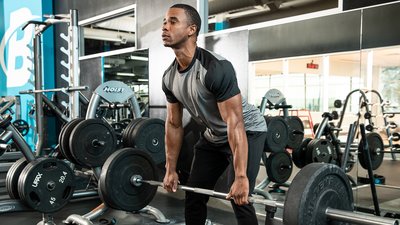Your badassery is about to take a back seat.
I've written a lot on Bodybuilding.com about different ways I like to take the ego out of lifting. I've let you know how getting brutally strong may get you hurt, why you need to stop maxing out, and why you need to earn training "rights" you may be taking for granted. What do all these have in common? Taking things down a notch and focusing more on the weak links in your chain, rather than testing that chain with the amount of weight you can lift.
Facing those weak links head-on could be exactly what you need to bring your strength and physique to the next level. So next time you feel the urge to show off for someone—even just for yourself—on a big lift, take a step back and spend some time getting humbled by these sneakily difficult movements. Learn under their tutelage, and you'll end up a better lifter, period.
1. Paused Deadlift
Applying pauses to exercises within the reps themselves can be a game-changer for almost any training effect you're looking to derive from the lift. And it's a good way to make your perceived exertion levels match that of a heavier lift, without nearly as much risk.
The conventional deadlift may benefit more from a well-placed pause than any other lift. Why? Because as weights get heavy, conventional pullers too often end up rounding that lumbar spine, looking like a dog about to do his business in the park. Don't give me that line about how so-and-so elite puller bent his back while setting some kind of record. For you, Mr. or Ms. Not Going After a World Record—and yes, for me—it's an unsafe pulling position.
Pausing mid-range forces the spine to remain neutral and teaches you to keep your hips from shooting up first before the weight leaves the floor. This allows your quads and glutes to contribute their fair share to the lift, and your lower back doesn't take the brunt of the work.
How to do it: When performing pauses, be sure to get tight in your start position and pull until the bar is no more than 6 inches off the ground. Hold that position for a distinct 1-2-second count, then continue the rep to completion. Doing sets of 3-5 with your typical 6-rep max is a smart directive.
2. Glute L-Bridge
If you're looking for a true challenge to your glute activation and strength, try glute L-bridges. I like using them to help individuals address anterior pelvic tilt issues, or overactive lower backs and hamstrings. That's most men, a decent percentage of women, and pretty much all desk jockeys.
A single-leg glute bridge on its own is a great exercise, but after a while, it's too rudimentary for some people. Adding a lateral component to the exercise via the hip rotation/abduction you see in the video makes the glute maximus and medius of the planted leg have to work much harder to maintain their contraction and prevent the body from twisting out of position.
Chances are, you'll never need to add extra load to this movement, as the raised leg is typically heavy enough. But the easiest way to progress this movement is to start with a bent knee and slowly work your way to a straight leg. Keep a slow tempo and stay aware of whether your spine slides into extension during the course of the set, which can happen quite easily. Build up to sets of 8-10 per leg.
3. Side Lying Adduction
This movement combines the adductors with oblique activation, and it's sneakily challenging. Here's why: Probably 90 percent of weight training is done in the sagittal plane. That includes all the forward/backward, up/down, flexion/extension exercises we all love. But very little gets done in the lateral plane, which is side-to-side movements. Lateral movements with load usually come second to lifts like deadlifts and squats, and this is one reason why many lifters exist in a world of chronic pain and consistent injury rehab.
For any joint to function correctly, it has to have relative balance between the muscles on both of that joint's sides. Squats, deadlifts, and even split squats provide tremendous bang for their buck, but we're tricking ourselves if we think that sagittal plane movements like these are all we need for truly healthy knees and hips over the long term.
Adduction and abduction-based exercises like this one take your hip, knee, and even lumbar spine and sacral health into consideration. It's likely you've been neglecting them, so it won't take long for you to realize how humbling they are.
4. Back Plank
Isometric training is typically another forgotten area, but it's worth its weight in gold—especially once you start mixing it up from the standards. We talk often about the importance of the standard plank, but isometric strength and endurance-based work is the cornerstone to training the characteristics of most postural muscles (hip flexors, spinal muscles, calves) as well. They are under constant demand with sitting, standing, and walking tall. And luckily, training these movements requires minimal equipment, and they're about as risk-free as strength training gets.
One of my favorites is the back plank, an unreal way to blast the postural muscles, rear deltoids, and intrinsic neck muscles. It's also an extremely difficult movement that can exploit weaknesses you didn't think you had—especially if you're a big, muscular lifter.
Sets of 15-second bodyweight holds are usually plenty for someone new to the movement. Clench your fists and keep your neck forward, chin up, and body as far off the ground as possible.
Progress this exercise by moving the benches farther away from one another, so there is less help from your arms to support your weight. No need to have a partner add a 25-pound plate on your chest—you won't need it!
5. Cobra Pull-down
Truthfully, I only have one real problem with pull-ups and pull-downs as back developers: They don't hit the lats through their full range of motion, as they are slightly compromised because of the hand position—even if you perform the motion exactly as the form police dictate. You can improve the situation by holding the bar with a narrower grip (think of a V-grip setup), but usually the shoulders will lose their set position and end up shrugged toward the ears.
The cable cobra pull-down solves this problem. Since you're responsible only for a single handle, you're able to reach farther overhead and slightly across the body. That equals a massive stretch for the lats, and the fact that you can manipulate your elbow and wrist position while doing this is doubly beneficial for back activation and healthy shoulders.
I find using an inclined bench sets the lifter up perfectly to mimic the slanted pattern of the lats' muscle fibers, making for even better activation. It won't take much weight to feel this, so train it for reps and add a pause at the bottom of each pull.
6. Z-Press
Plenty of seriously strong lifters love this barbell press variation, for the simple reason that it absolutely forces them to check their egos at the door. It creates a "no excuses" strict press pattern that cuts out leg drive and back support. It also exploits the mobility of both your hips and shoulders—and exposes any slouching or cheating.
If you don't have good ROM at either and can't do the lift on the floor, just sit on a low step platform or plate. If you have issues achieving and maintaining an upright posture with straight knees, slightly bend the knees until you find a strong and safe-feeling position. I love performing these in the rack and using the safeties to help get into position, because unracking a barbell for the Z-press is no fun.
Use identical mechanics to a typical barbell overhead press—besides the seated position, obviously. Tuck your elbows and drive your head "through the window" you create with your arms at the top.
I prefer and recommend sets of 6 or more reps due to the nature of the lift. Chances are, you won't even scratch your strict press numbers. But once you push your strength on this lift, your strict press will skyrocket.

